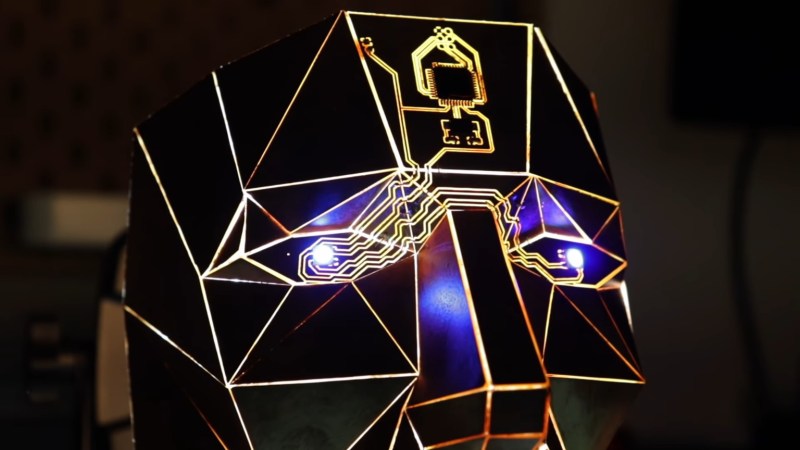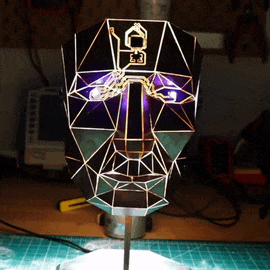Paper craft has been around almost as long as paper itself. It’s fun to mimic paper craft and origami with low-poly 3D prints, and [Stephen Hawes] wondered whether it could be done with copper-clad PCBs. Two years after the question arose, we have the answer in the form of a fantastical mask with light-up eyes. Check it out in the video below.
[Stephen] started with a model (Update: [kongorilla]’s 2012 low poly mask model from back in 2012 was the starting point for this hack) from the papercraft program Pepakura Designer, then milled out dozens of boards. Only a few of them support circuitry, but it was still quite the time-consuming process. The ATmega32U4 on the forehead along with the fold-traversing circuitry serve to light up the WS2812B eyes. Power runs up the copper tube, which doubles as a handy mounting rod to connect to the 3D printed base.
To be fair, eighteen months out of the two years this project took was spent hand-sanding a chamfer on every edge of every panel so that they could be glued together. Soldering the edges together didn’t work as well as you might think, so [Stephen] used Superglue mixed with baking soda to give it body and make it dry faster. The result is a low-poly human face of shiny copper with TQFP-44 chip package a the all-seeing eye in the middle of its forehead like something from Tron come to life.
Thanks to [Sophi] and [BaldPower] for the tip!

















Not origami. Stunning artwork. The face of modern Atmega or Atmega Man or…
Stained glass work should be easier now with that training.
Yeah, its not origami – but then even in things that are called origami there’s ambiguity – are cuts allowed at all? Multiple parts? etc… For myself I lean towards single sheet, with no cuts. But allow for multiple identical modules for things like fancy polygonal shapes.
Still this is so cool. Now all it needs is to be an actual functional facemask for this covid bollocks and the flashing angry eyes if folks step into your space… Certain to attract people rather than repel as its just too damn pretty..
If you cut the paper, it would be kirigami, not origami. There’s also versions of both that are modular, where the end result is made of two or more pieces combined into a larger whole. I guess this project would be more like… modular kirigami, if anything? Except it’s not paper.
Stunning.
I can’t help but wonder if a low poly model in something like blender could be sectioned to output the individual faces here with some scripting. Then you could just route out the lot on a pcb mill. Cheating, but the good kind.
Might have to try this. :)
That’s pretty much what the P*ura craft program mentioned does, so should be able to take its output straight to the mill..
I expect in practice because PCB’s have a significant thickness you would need to tweak bits here and there or mill with a V bit that makes a mitre of the PCB at the joints…
I’m the original creator of the mask model (uncredited by [Stephen] in his video, for some reason, ignoring the CC license). It was in fact created in Blender, and unfolded in Pepakura. There are scripts for doing it all in Blender, but not as feature-rich as Pepakura.
Here’s the link to the original files: https://www.thingiverse.com/thing:32189
Would NoT care to see it damaged or perverted for face mask Nazi use.
Origami is paper folding. I would stay in the comfortable area of one sheet of paper folded to make a single object. Many can be combined to make a larger object. Exceeding that definition Im going to stick with being otaku and ignorant of higher Japanese cultural definitions.
Pepakura Is something a modeler should look at FWIW.
WOW! This is what every evil sci-fi android should look like!
Reminds me of the face from: Bag raiders – shooting star
Awe man.,,,18 months. The copper is bad ass but now they got conductive filament and copper in that Protopasta.,,so you could have this in 18hrs.
One of those things when you get creative is trying to beat the clock against marketable technology that takes away from the craftsmanship involved, this really was impressive….his work area very clean…minus his shirt.
Awesome result.
But keep in mind that PCB material is made out of fiber glass usually. It’s dust can cause cancer in your lung… I’d be a bit more careful while sanding that stuff.
Imagine doing that with the OSH Park After Dark black + transparent solder mask. cool copper details without tarnishing.
Correction to this post: He did not start “with a model from the papercraft program Pepakura Designer.” He started with my work. Then he gave me no credit, in violation of the model’s CC-BY-NC-SA license. The original files and license can be found here: https://www.thingiverse.com/thing:32189
Since it was released under a Share-Alike license, [Stephen] Hawes needs to post his files somewhere with the same license.
The model is different
[Stephen] Hawes has updated his project page and the description of his youtube video to reflect the fact that he used my mask design in this project. So, Luis, your statement is beside the point. He changed my basic design so it could be made from PCB, and added some cool details. That’s all good. He only neglected to follow the terms of the license. It’s not that hard — just give credit, share your derivative files under the same license, and don’t use for commercial purposes. He wouldn’t want me taking one of his videos, use it for my own purposes, and then neglect to mention that it was partially his work, would he?
Sorry to hear. You are right